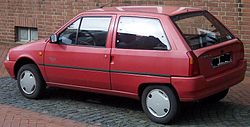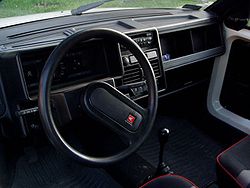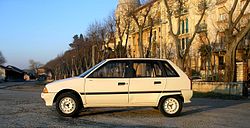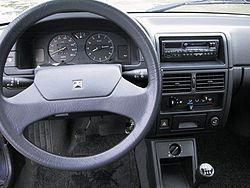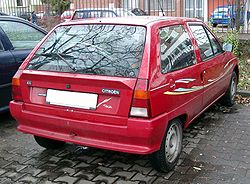- Citroën AX
-
Citroën AX 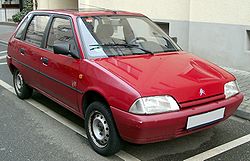
Manufacturer Citroën Production 1986-1998
2,425,138 builtAssembly Rennes, France Predecessor Citroën LNA
Citroën Axel
Citroën VisaSuccessor Citroën Saxo Class Supermini Body style 3- and 5-door hatchback Layout FF layout Engine Petrol: 1.0 L, 1.1 L, 1.3 L, 1.4 L
Diesel: 1.4L, 1.5 LTransmission 4 or 5 speed manual Wheelbase 2,280 mm (89.8 in) Length 3,525 mm (138.8 in) Width 1,555 mm (61.2 in) Height 1,355 mm (53.3 in) Curb weight 640–850 kg (1,411–1,874 lb) The Citroën AX is a supermini built by the French manufacturer Citroën from 1986 to 1998. The AX was launched at the 1986 Paris Motor Show to replace the Citroën Visa and Citroën LNA.
Contents
Overview
Development of this model started in 1983, and was initially also going to form the basis of a sister model from Talbot to replace the Samba; however, the falling popularity of the Talbot brand had led to Peugeot deciding to axe it by the time the Citroën AX was launched, and so the Talbot version never made it into production.[1]
The car was available from its launch on 2 October 1986[2] as a three-door hatchback with 1.0, 1.1 and 1.4-litre TU-series belt driven OHC engines. Shortly afterwards, a five-door model and a 1.4 diesel were introduced; the latter was later replaced by a 1.5-litre unit. It had fully independent long travel suspension. It was initially backed by a memorable TV advertising campaign filmed in China, starring actress Janet Mas and an elderly gentleman, whose character was simply known as Mr Wong.
The car was very economical, largely because of excellent aerodynamics for its class of car (drag coefficient of 0.31) and a very light weight of 640 kg (1,411 lb) for the basic version. This was due to the extensive use of plastic panels in non-load bearing areas and varying the thicknesses of steel in the bodyshell to be the minimum needed to take required loads. It also optionally used self coloured plastic bumpers. This technology came from the PSA Peugeot-Citroën / Renault / French government ECO 2000 project.[3] The production version was much more conservative than the original 'one box' design prototype, that was closer to the Eco 2000 styling after negative reactions in focus groups.[4] The 'one box' supermini eventually came to market with the early '90s Renault Twingo. In 1989 a naturally aspirated diesel AX, using the 1360 cc all aluminium alloy TUD engine, managed a figure of 2.7 litres per 100 kilometres (100 mpg-imp; 87 mpg-US), totalling over 1,000 miles (1,609 km) from Dover to Barcelona. This was the longest ever distance travelled on 10 imp gal (45.5 L; 12.0 US gal) of fuel and earned it a place in the Guinness Book of Records as the most economical production car. Also available was a 4x4[5] variant, but with limited success when compared to the rival Fiat Panda 4x4. This was not sold in the UK.
The first performance version was the limited-run AX Sport from 1987, with a 1.3 engine and twin carburettors producing 95 bhp (71 kW; 96 PS), wearing iconic white steel wheels (5,5" x 14") which resembled those on its brother, the Peugeot 205 Rallye. The AX Sport used Solex ADDHE 40 carburettors until 1990 and was then replaced with Weber DCOM 40s, just like the 205 Rallye 1,3. The AX Sport had a shorter inlet manifold than the 205 Rallye, to save room in the smaller engine compartment. Later on the sport was lightly revised, available in other colours and with optional GT wheels. Later, the AX 14GT, with a single-carburettor 85 bhp (63 kW; 86 PS) 1.4 engine also found in the Peugeot 205 XS, was introduced. From 1991, this model utilised fuel injection to coincide with the revamp of the entire range and to coincide with tougher 1992 EU emission regulations that introduced exhaust catalytic converters.
Late 1991 saw the range revised, with a heavily face lifted tailgate and interior being the most notable changes. The following year saw the introduction of the most powerful AX variant, the 100 bhp (75 kW; 101 PS) GTi. The GT was sold alongside the GTi for a few months, but was eventually phased out. New models were introduced such as the Forte, Spree, Elation and Dimension
The range was slimmed-down in 1996, following the introduction of the Saxo, with production of the AX ending in 1998 after a 12 year production run. A total of 2,425,138[6] AXs were produced.
In January 1995 the Citroën AX Echo was created, reaching a top speed of 110 mph (180 km/h). Its competitor at the time, the Peugeot 106 Ski, was lacking interest on buyers in Europe whilst the Citroën AX's sales were sky high.
The Peugeot 106 and Citroën Saxo were both developments of the AX. They followed the '90s trend for heavier, more solid and 'safer' feeling cars that continues today. The AX was designed for lightness, with a 'less is more' philosophy, but with more conventional styling than previous Citroëns.
AX derivatives
In 1996 the EV3 engine (air engine) was mounted into a regular Citroën AX car by MDI.
Heuliez presented an estate version called the AX Evasion at the 1988 Mondial de l'Automobile.
The Citroën AX BB Cabrio was a small roadster derived from the AX (1988). In Portugal, Citroen dealership Benjamin Barral created an unofficial convertible version, called the BB Cabrio, originally powered by the twin-choke carb AX GT 1.4 L engine, but later available with any type of engine that equipped the 3 door AX. Considered very handsome, due to the lack of the usual roll bar that convertible normally require, these cars are now collector's items and command a heavy premium over the normal models they are based upon. This model was not sold in the UK.
At one stage, parent firm PSA Peugeot Citroën had planned to launch a Talbot Samba replacement as a version of the AX with a different grille and a Talbot badge, but this plan was cancelled, as the entire Talbot marque was axed in the same year the AX was launched.
Malaysian car company Proton produced a version of the Citroën AX, the Proton Tiara, from 1996 to 2000.
Aixam Mega at one time built an AX derivative called Mega Club. It was somewhat inspired by the Méhari, with a plastic bodywork and an optional convertible version, with 2 wheel drive or four wheel drive. It was discontinued in 1998. A competition version of the Mega Club with a tubeframe chassis raced in the Andros Trophy in the early 1990, but powered by Ford and Honda engines.
References
- ^ "covering Chrysler Europe, Rootes Group, and Talbot cars". Rootes-Chrysler.co.uk. http://www.rootes-chrysler.co.uk/samba-replace.html. Retrieved 2011-08-01.
- ^ "The mood of car firms in France on upswing". Pqasb.pqarchiver.com. http://pqasb.pqarchiver.com/thestar/access/475526771.html?FMT=ABS&FMTS=ABS:FT&type=current&date=Oct+11%2C+1986&author=(REUTER)&pub=Toronto+Star&desc=The+mood+of+car+firms+in+France+on+upswing&pqatl=google. Retrieved 2011-08-01.
- ^ "ECO 2000 - Citroenet". http://www.citroenet.org.uk/prototypes/eco2000/eco-2000.html. Retrieved 2010-01-07.
- ^ "Citroën S9 - AX prototypes - Citroënet". http://www.citroenet.org.uk/prototypes/projet-s9/s9.html. Retrieved 2010-01-07.
- ^ Car: Citroen AX 4x4 at fullworld.eu
- ^ "History". Citroen AX .Net. 2011-07-25. http://www.citroenax.net/history.htm#54549308. Retrieved 2011-08-01.
External links
- Citroën AX Club Benelux Forum
- Citroën AX at Citroenet
- CITROENS: Proton Tiara
- AX links at Citroën World
- CITROËN AX on the Road
- AX Owners Club Forum Website
- AX French Owners Club Forum Website
- AX Spain Club Forum
- Citroen AX .Net Site
« previous — Automobiles Citroën, a subsidiary of the PSA Peugeot Citroën since 1976, car timeline, 1980s–present Type 1980s 1990s 2000s 2010s 0 1 2 3 4 5 6 7 8 9 0 1 2 3 4 5 6 7 8 9 0 1 2 3 4 5 6 7 8 9 0 1 Economy car 2CV Off-roader Méhari City car C1 Supermini LN / LNA AX Dyane Axel Saxo I Saxo II C2 DS3 Visa C3 I C3 II Small family car GSA ZX Xsara I Xsara II C4 I C4 II DS4 Large family car BX Xantia C5 I C5 II DS5 Executive car CX XM C6 Leisure
activity vehicleAcadiane C15 Nemo Berlingo Berlingo II Compact
MPVXsara Picasso C3 Picasso C4 Picasso Large MPV Evasion/Synergie C8 C4 Grand Picasso Crossover C-Crosser Convertible C3 Pluriel Van H Van C25 Jumpy I Jumpy II C35 Jumper Jumper II Categories:- Citroën vehicles
- Subcompact cars
- Front wheel drive vehicles
- 1980s automobiles
- 1990s automobiles
- Vehicles introduced in 1986
Wikimedia Foundation. 2010.

